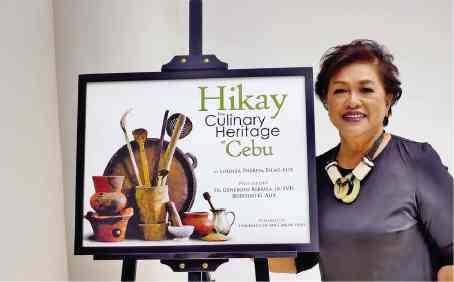
Usually, I meet the authors of books only through their work and the biography that introduces them somewhere in the back of the book, just before the first chapter or on the sleeve of the book jacket.
But I was to have lunch with the author of “Hikay: Culinary Heritage of Cebu” (University of San Carlos Press, 2013) to get to know her better, because I was to introduce her during the book’s launch the next day at the QCX Museum at the Quezon City Elliptical Circle.
It surprised me to learn that Louella Theresa Eslao Alix started writing very late. And what did she do before that? She was a housewife, was her matter-of-fact reply, though with a little shop called Presents and Such Tearoom and Café, where she served beverages and apple pie when she was in the mood.
Though she started late writing professionally (she had been writing all these years but only for herself, she said), she has already authored several books: “Balaanong Bahandi: the Sacred Treasures of the Archdiocese of Cebu,” “Mandaue: Our Home, Our Pride, Our Future,” and a history of Bantayan Island. She is also the co-author of “Via Veritatis: The Biography of Ricardo Cardinal Vidal.”
Everyday cooking
“Hikay” in Cebuano means to prepare food for a feast or for everyday cooking. “Hikay,” the book, was the result of a chapter on the food in the Mandaue book which she and those who read it thought she had done well and needed broadening. The new book covers the whole of the province, the main island and the more than a hundred other islands included in its political boundaries.
During the launch, Louella talked first about her native landscape, aided by photographs from the book taken by Fr. Generoso Rebayla Jr., SVD, and her husband Rodolfo Alix. She explained how the mountain range in the middle of the main island separates the east and west towns, and has limited the arable land for planting the ancient cereal of millet or kabog and rice, and the now preferred corn brought by the Spanish. The richness of the province’s cuisine comes from the surrounding seas with so much marine life.
Freshness
And what do Cebuanos look for in their cooking? it is freshness, and the simplicity in their cooking aims to preserve that freshness.
The kinds of cooking can be summed up in the most famous contraction in Philippine cuisine—“sutukil” for sugba, tula or tinowa, and kilawin or kinilaw. That has even be shortened to STK, and those letters can be seen throughout the province’s eateries.
Grilling or sugba doesn’t require too much in terms of flavoring, just a bit of seasoning and then the freshness is allowed to do its work. Tinowa or boiling has to have a clear broth, the author emphasized, and the taste is not as sour as the Tagalogs like in their sinigang.
Kilaw is just simply bathing in acid, in coconut vinegar, with the addition of coconut milk when fish is used.
Distinctly Cebuano
But there are other dishes that are identified as distinctly Cebuano. There is bam-I, a two-noodle dish whose origin undoubtedly is Chinese. As is timke, steamed chicken cooked with Ginebra Mallorca, a local aromatic gin.
The preferred way with adobo is cooking it until the sauce has dried up. But like the adobo, many other dishes like dinuguan and menudo also have versions in the country, each one’s version bruited about as the best—just like Cebu lechon, though Cebu’s version has been promoted successfully as the best in the country.
But the author is more interested in the lechon versions around her province and how even the stuffing used are different, such as the epazote in one area, an herb that has the smell of anise and was brought here from Mexico. She added the account of Antonio Pigafetta, chronicler during Ferdinand Magellan’s voyage, who described the native ritual before the pigs are slaughtered to make lechon; this included dancing, chanting and the blowing of trumpets by old women.
Traditions
In the book, the author also pays tribute to the grandmothers and mothers who by their cooking have continued the culinary traditions of Cebu. The book is dedicated to one of them, Maria Rallos, who wrote and published a recipe book in the 1920s, a feat for a woman during that time.
Then there were those who studied and eventually taught Home Economics and made recipes using home measurements such as cups and teaspoons instead of a “pinch” or a “palm-full.” One of those women is her grandmother, Leonila Abao, who decreed that Louella should stay beside her as she cooked so she could learn what was termed then as “woman’s work.”
In the process, Louella learned her grandmother’s techniques and secrets; even today, she said she can do the recipes from memory. Because she can cook, Louella was able to test the recipes in the book.
We wish there could be more books on regional cooking like “Hikay,” a Cebuana writer’s research into cooking that is distinctly Cebuano. There are so few I know of—“Naimas,” which is about Ilocos Sur cooking, and “Karasa,” a Samar food book, to name two.
Not exactly a book but will do for the meantime is a Cavite cooking compilation, recipes in photocopy paper held together by staple wire and with a mock-up cover of ordinary folder. I have bits and pieces of handwritten recipes from Bicol and Bulacan and a typewritten selection of Ilocos Norte dishes.
I hope each place will have an author who can write a book and educate us not only on local recipes but also the eating habits and preferred ingredients of that region, not to mention the people who continue their traditional cuisine and specialties.
“Hikay: Culinary Heritage of Cebu” is available online at The Kitchen Bookstore.
What’s up next? The launch of Bryan Koh’s “Milkier Pigs and Violet Gold: Philippine Food Stories” on Sept. 24.
E-mail the author at pinoyfood04@yahoo.com.